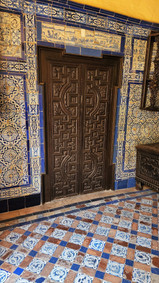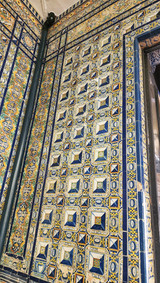Seville's Mosaic and Tile Wonder | Palacio de la Condesa de Lebrija
- AudrieZS

- Jul 16, 2022
- 3 min read
Updated: Aug 3, 2022

If it's possible for something to hide in plain site, it's the Palacio de la Condesa de Lebrija in Seville, Spain. Once inside, the Sevillian tile and Roman mosaics are stunning and you wonder why you haven't heard more of this living museum.
The Palacio is steps from Seville's iconic "mushroom," within walking distance of the Plaza Mayor, and just north of Seville's historic city center. The house is the artistic and historical vision of the widowed Contessa who once lived there.
It's an eclectic mix of everything from Roman mosaics to Sevillian tile, with a dash of Asian, peppered with a few valuable paintings from artists like Van Dyke and sprinkled with belles artes from around the world. Doña Regla Manjón Mergelina, the Countess of Lebrija, was by all accounts a remarkable woman. The Palacio was built as a townhouse in the 16th century, but her purchase of it in 1901 saw it refurbished and embelllished to reflect her passion for archeology and fine arts. Her pursuits resulted in her being the first woman elected a member of the Real Academia de Bellas Artes de Santa Isabel de Hungria. Later, she was elected to the Real Academia de Bellas Artes de San Fernando in Madrid. Her work in charitable causes such as the fight against tuberculosis, raising funds for military hospitals, and efforts to help abandoned children saw her awarded the Grand Cross of Charity by King Alfonso VIII.

She had no children but her family heirs operate the home today, which has been open as a museum since about 1999. They keep the upper floor furnished as it was when the Contessa was alive. It's my understanding that the family uses the home about once a year.
This article may contain affiliate / compensated links where we might make a small commission at no cost to you. Thank you for your support in helping to bring you quality content. For full information, please see our disclosure here.
This was our last site visited on our four days in Seville. While walking from the nearby Metropol Parasol, my husband suggested we visit, as he had read about it in a tour book and it was steps away. As with most sites, they encourage purchase of entry tickets online, but we walked right in mid-morning. The 12€ entry fee includes access to the ground floor (on your own) and a guided tour of the upstairs.

The first thing you notice upon entry (and what drew me in) is the entry floor, replete with various types of marble in a style known as Pietra Dura. Using harder and semi-precious stones that are polished and inlaid, this medieval technique reminded me of our visits to the Medici Chapel in Florence, Italy.
The ground floor features an extensive Roman tile floor which was purchased from a property in the Roman Italica area, northwest of Seville. The courtyard features Mudéjar plaster work like that seen in historic sites throughout Andalusia and other parts of the Iberian peninsula, where Muslim workers were permitted to remain by Christian kings. It's an adaptation of Muslim style to Christian architecture and is an amazing example of skilled craftsmanship.
If that wasn't enough, the walls on the ground floor are covered with azuejos--those beautiful blue and white (frequently with yellow/gold) tiles known in Andalucia and Portugal-- salvaged from a convent.
In the courtyard and sprinkled in to other rooms are examples of art and antiquities from many cultures and time periods.
While you can spend as much time as you want exploring the ground level on your own, the upstairs is accessed only by a 30-minute guided tour, given periodically throughout the day and included in the entrance fee. No photos were allowed upstairs, but their website gives you a sense of what the sitting rooms, chapel, bedroom and library are like. The Contessa, not surprisingly, had an extensive library that reflected her interest in history.
The tour is worth waiting for. On our visit, we had young guides providing an enthusiastic history and perspective on the rooms and items, all still decorated in the manner they appeared while the Contessa was living.
If you are looking for a great place to stay in Seville, try where we stayed, the H10 Corregidor Boutique Hotel. Sounds expensive, but wasn't and that perfect balance of close to some sites but still quiet. Optional (and fantastic breakfast), comfy beds, a glass of bubbly cava at check in. And who doesn't like to eat breakfast at an open-air patio with a fountain?




























Comments